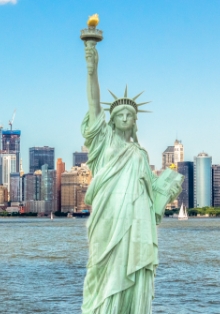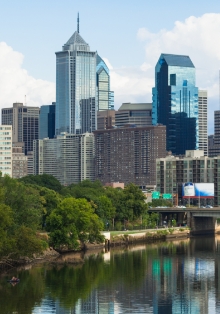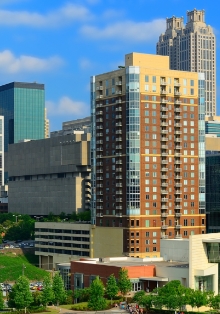The United States of America (USA) is a vast country with the most foreign-born residents in the world (about 47.8 million), largest economy, best schools, cutting-edge medical care, and an overall high standard of living.
The USA is the fourth largest country in the world, stretching from the Atlantic Ocean on the east to the Pacific Ocean on the west and bordered by Canada to the north and Mexico and the Gulf of Mexico to the south.
There are approximately 337,200,000 (2024) people living in the USA, making it the world’s third most populace country, after China and India.
The US is divided into 50 states and each state is further divided into numerous counties (with the exception of Louisiana which has parishes).
The largest states in the USA in terms of size include: #1 Alaska, #2 Texas, #3 California, #4 Montana, #5 New Mexico, #6 Arizona, #7 Nevada, #8 Colorado, #9 Oregon, and #10 Wyoming.
California has most residents living within its borders (39.5 million), followed by #2 Texas (29 million), #3 Florida (21.5 million), #4 New York (19.5 million), #5 Pennsylvania (12.8 million), #6 Illinois (12.6 million), #7 Ohio (11.7 million, #8 Georgia (10.6 million), #9 North Carolina (10.5 million), and #10 Michigan (9.9 million).
The largest cities in the United States include: #1 New York City (8.2 million), #2 Los Angeles (3.9 million), #3 Chicago (2.6 million), #4 Houston (2.3 million), #5 Phoenix (1.7 million), #6 Philadelphia (1.5 million), #7 San Antonio (1.5 million), #8 San Diego (1.4 million), #9 Dallas (1.3 million), and #10 San Jose (one million).
According to the Pew Research Center (2020), the metropolitan areas with the most immigrants living in the USA are: New York City, Los Angeles, Miami, Chicago, San Francisco, Houston, Dallas-Ft, Worth, Washington, DC, Atlanta, Riverside, Boston, San Diego, San Jose, Seattle, Phoenix, Las Vegas, Orlando, Tampa, and Sacramento.

New York City is the
largest US city, with 18.8
million people living in the
metro area, and is the
world’s financial capital.

The Los Angeles metro
area is home to 12.5
million residents as well as the Hollywood film and television industry.

There are 8.8 million
people living in the
Chicago area, which is
known for its skyscrapers,
cuisine, museums and
beaches.

Seven million people live in the Houston metro area, which is known for NASA’s Johnson Space
Center and Mission
Control.

The Washington, DC,
metro area has 6.3 million
residents, who can enjoy
museums, monuments
and many US job
opportunities.

The 6.2 million residents
who live in the Miami
metro area get to relax on
sunny beaches and have
nice weather year-round.

Philadelphia has a metro
population of 6.1 million
people and is where the
Declaration of
Independence was signed.

The Atlanta metro area is
home to 6 million
residents, the world’s
busiest airport and
headquarters for CNN,
Coca Cola and other firms.
Keep in mind that US Permanent Resident Green Card holders and temporary foreign workers (for example, those having an H-1B Visa) are free
to live and work in the USA wherever they want, whether in a major city, suburb, small town, out in the country, at the beach, in the mountains,
etc.
The Niche.com website has posted lists of its rankings of the best places to live in the USA, best cities for families, most diverse places to live in
America, and the best places to buy a house in the United States, which may provide useful information for you and your family.
The United States has the world’s largest economy, which boasts a Gross
Domestic Product (GDP) of $27.3 trillion (2023) according to the World
Bank.
By comparison, the next biggest GDPs belong to China ($17.7 trillion),
Germany ($4.4 trillion), Japan ($4.2 trillion), India ($3.5 trillion), the United Kingdom ($3.3 trillion), France ($3.0 trillion), Italy ($2.2 trillion), Brazil ($2.1 trillion) and Canada ($2.1 trillion).
America’s massive economy produces millions of new jobs in the USA each
year in the aerospace, automotive, chemicals, construction, education,
electronics, engineering, finance, healthcare, information technology, media,
pharmaceuticals, retail, transportation and other business sectors.
Employers across the United States in various business sectors have been
finding it challenging to fill the approximately 11.3 million US job openings
that are currently available (March 2022), according to the Bureau of Labor Statistics.
This is good news for you if you have a United States Permanent Resident
Green Card or a temporary US work visa (such as the popular H-1B Visa),
since foreign workers are in high demand in the USA.
Furthermore, US jobs generally pay well, as you can see from the average
annual salaries listed below for various jobs in the USA (Source: US Bureau
of Labor Statistics, 2023):

Immigrants living in the USA have the opportunity to attend high-quality education programs in the United States.
Public primary and secondary education is free for children under 18 years of age in all 50 US states.
The public schools in the United States are usually administered at the local level through elected school boards and districts with funding coming from local property taxes or other revenue, so where you live can make a significant difference in the quality of the public schools your children attend.
In order to assist parents in finding a good school for their children in the United States, Niche.com has posted its 2021 rankings of the:
Please note that parents can search for other categories of schools, search for schools by location and other parameters at Niche.com.
Adult immigrants living in the USA also have the opportunity to receive a world-class education at vocational schools, two-year community
colleges, four-year colleges and universities throughout the United States.
According to the National Center for Education Statistics, the U.S. has 3,982 degree-granting colleges and universities including:
US News & World Report has posted its 2022 rankings of the best universities in the United States for various undergraduate and graduate programs which may be helpful in choosing where to apply for higher education in the USA.
Niche.com has also posted its evaluations of the top colleges and universities as well as the best graduate schools in the United States which may be a useful tool for selecting where to apply for US post-secondary education.
One way to save money on a university education in the United States is to complete the first two years of a four-year post-secondary program at a local two-year community college and then apply to transfer to a four-year university that has a matriculation agreement with the community college in order to complete your bachelor’s degree from the university (this is also a way to attend a four-year university if your GPA or ACT/SAT score is not high enough to be admitted as a freshman student).
It should be noted that US Permanent Residents (Green Card holders) and American citizens can apply for federal financial aid, using the Free Application for Federal Student Aid (FAFSA), which will be analyzed by a university’s financial aid office to determine whether a college or university student qualifies for grants, scholarships, on-campus work-study, or low-interest student loans.
 The United States has the most advanced healthcare and medical technology in the world.
The United States has the most advanced healthcare and medical technology in the world.
In addition to being available to people living in the USA, many people from around the globe travel to the United States (“medical tourists”) to receive cutting edge medical treatments that are not available in their own country or which are very expensive.
Unlike most developed countries, however, healthcare is not free to all citizens and permanent residents in the US (there is no universal public healthcare), with the exception of senior citizens who qualify to receive Medicare; and low-income families that qualify to get Medicaid and/or the Children’s Health Insurance Program (CHIPS).
Nonetheless, quality healthcare is available to most people living in the USA through private health insurance plans.
Many employers in the United States offer health insurance coverage to their employees as part of their employment benefits.
Some employers will pay all the health insurance premiums for their employees, but it is common for the employer to pay a certain percentage of the healthcare premiums and for the employee to pay a particular portion of the premiums which are deducted from their paycheck.
In the event that a person living in the USA chooses to pay for their own healthcare coverage totally on their own, it can be rather expensive.
For the minority of people living in the US who did not have healthcare coverage for one reason or another, the Affordable Care Act (ACA) was
passed by the Congress and signed into law by President Barack Obama in 2010 (nicknamed “Obama Care”), in order to make affordable
healthcare available to everyone living in the USA who needs it.
There are different types of private healthcare insurance coverage in the United States, such as the Health Maintenance Organization (HMO),
Preferred Provider Organization (PPO), Exclusive Provider Organization (EPO), and Points of Service (POS).
An HMO generally requires a patient to receive healthcare from one of the doctors who is a member of its network.
A PPO lets a patient visit doctors or hospitals outside of its network, however, the patient will pay less if he or she receives healthcare services
from a doctor or hospital that is part of the PPO network.
With an EPO, the medical care is only covered (except in emergencies) if the patient visits hospitals, doctors or specialists in the EPO network.
The POS plan provides a patient with lower cost coverage if they visit a hospital, doctor or other healthcare provider that is in the POS network
and requires a referral from the patient’s primary care physician in order to see a specialist.
It is also important to know the difference among the bronze, silver, gold and platinum healthcare insurance plans in the United States, which refer
to how the patient and healthcare insurance provider split the costs:
For more information about healthcare in the United States, visit: https://www.healthcare.gov/choose-a-plan/comparing-plans/
In the United States, political power is divided between the federal (national) government and the 50 US state governments.
Back in the late-1700s, the Founding Fathers of the United States (e.g., George Washington, Benjamin Franklin, Thomas Jefferson, James Madison, Alexander Hamilton and others) wanted to create a representative democracy in which there would be “separation of powers” and “checks and balances” so that no single branch of government would have too much power.
Political power is divided at the federal level among the Executive Branch (i.e. President of the United States), Legislative Branch (i.e., American Congress, which is divided into the House of Representatives and the Senate), and the Judicial Branch (i.e., the US Supreme Court and lower federal courts).
Similarly, political power in each of the 50 US states is divided among the Executive Branch (i.e., Governor), Legislative Branch (i.e., State Assembly, but other names are used by different states), and Judicial Branch (i.e., the State Supreme Court and lower state courts).
The President of the United States, who lives and works in The White House, is elected by American voters in national elections held every four years, can be re-elected to one more four-year term, and along with his or her Cabinet, is responsible for the execution of federal laws through the various departments and agencies of the US national government (e.g., US Department of Labor, Environmental Protection Agency, etc.).
The US president is also supposed to represent all of the people living in the United States (particularly during a national crisis), may introduce proposed legislation to Congress (such as the federal budget), and signs bills passed by both houses of Congress into law (or in some cases, may “veto” a bill).
The United States Congress is divided into a lower house (US House of Representatives), which has 435 members, and an upper house (US Senate), which has 100 members, and both houses of Congress conduct their work at the iconic white-domed US Capitol building in Washington, DC.
The number of Congressmen from each state elected to the House of Representatives is determined by each state’s population as counted by a US Census held every 10 years (e.g., California, which has over 39 million residents, gets 53 Representatives from various Congressional districts throughout the state, while Wyoming, with only 580,000 residents, has just one Representative for the entire state).
American voters from each of the 50 states will elect two US Senators to represent them, regardless of the population of the state (e.g., California has two US Senators and Wyoming also has two US Senators, etc.).
It should be noted that the Speaker of the House is third in line of succession after the US President and Vice-President (for example, if the President dies in office, resigns or is incapacitated, the Vice-President will be sworn in by the Chief Justice of the US Supreme Court as the “Acting President”, but if both the President and Vice-President die in office, resign or are incapacitated, the Speaker of the House would be sworn in as “Acting President”).
Both the House of Representatives and the Senate propose separate legislation (known as a “bill”) regarding issues that affect the United States and a single compromise bill must be approved in a joint committee before going to The White House to be signed or vetoed by The President.
Another important responsibility of the US Congress is to provide oversight over the Executive Branch through various congressional oversight committees.
The US Supreme Court is the highest court of jurisdiction in the United States, has nine Justices who are appointed for life by the President and confirmed by the Senate, and it rules on the most important court cases in the USA.
When the United States Supreme Court is reviewing a case, each of the nine justices will be interpreting the law or situation in question to determine whether the US Constitution, including the Bill of Rights, is being complied with or if the law is unconstitutional.
It is important to know that the US Constitution is the highest law in the land and it defines the powers and limits of government and lists 10 fundamental freedoms guaranteed to all American citizens and permanent residents in the Bill of Rights.
Examples of some of the freedoms listed in the Bill of Rights include: freedom of religion; freedom of speech; freedom of the press; freedom for the people to peaceably assemble (for example, to protest); freedom of the people to petition the Government to remedy grievances; freedom related to search and seizure by the authorities; right to a speedy and public trial by an impartial jury; freedom from cruel and unusual punishment – among many other freedoms.
 In general, people living in the USA enjoy a high quality of life.
In general, people living in the USA enjoy a high quality of life.
According to the Organization for Economic Cooperation and Development (OECD), “The United States performs very well in many measures of well-being relative to most other countries in the Better Life Index. The United States ranks at the top in housing and ranks above the average in income and wealth, health status, jobs and earnings, education and skills, personal security, subjective well-being, environmental quality, social connections, and civic engagement” (OECD, Better Life Index).
As mentioned previously, there is a general high standard of living in the USA, since it has the world’s largest economy; US jobs tend to pay well; America’s top-rated educational institutions can open the door to great career options and socioeconomic mobility; cutting-edge medical care is available to people living in America; and the power of government is limited and many freedoms are guaranteed in the US Constitution and Bill of Rights.
Furthermore, many people who visit or immigrate to the United States are amazed at the variety (and low prices) of goods and services that are available, from groceries to consumer electronics to vehicles to housing and more!
People living in America as well as tourists from around the globe have unlimited points of interest to visit, including 423 national park sites (such as the Grand Canyon, Yellowstone, Yosemite, and Statue of Liberty); beautiful beaches (including Maui in Hawaii, Laguna Beach in California and Miami Beach in Florida); amusement/theme parks (such as Disneyworld in Florida; Disneyland, Knott’s Berry Farm, Universal Studios, Six Flags Magic Mountain, and Sea World in California); some of the world’s best museums (such as the Metropolitan Museum of Art and Museum of Modern Art in New York City; the Art Institute in Chicago; National Gallery of Art and Smithsonian Institution in Washington, DC; Getty Center and Los Angeles County Museum of Art in Los Angeles; and the Museum of Fine Arts in Boston).
When it comes to playing or watching sports in the United States, you can choose from baseball (“the great American pastime”), American football, basketball, soccer/football, golf, tennis and many other activities.
Music lovers can listen to some of the world’s top classical symphonies (such as the New York Philharmonic, Los Angeles Philharmonic and Boston Symphony Orchestra), and enjoy concerts from a range of performers in the rock music, country music and other musical genres.
There is so much to see and do living in America that a person could spend a lifetime exploring this incredible country and still not experience all that the United States has to offer!
A new life full of possibilities is waiting for you in the United States of America.
Global USA can help you and your family have the chance to live the American Dream as a US Permanent Resident Green Card holder.
We will make sure that your Green Card Lottery application and photo(s) meet the Diversity Visa Program standards before we submit them to the DV-Lottery on your behalf, and we will contact you promptly if you are selected as a DV-Lottery winner so you can start the consular process to receive a Green Card as soon as possible.
So, what are you waiting for?
www.globalusagreencard.com is owned and operated by GLOBAL WORLDWIDE IMMIGRATION LIMITED (UK), Company
Number 09958501, Lynton House, 7-12 Tavistock Square, London, United Kingdom, WC1H 9BQ, which is a private entity and is not a
government agency nor a law firm.